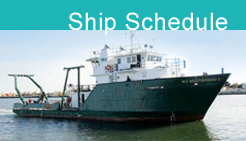Deep Sea Fish and Sediment Surveys in the Gulf
Red fish, Blue Fish, One fish, Two fish…
Many times during the scientific process, a scientist will be presented with an opportunity to change their original plan and adapt to accommodate this change. This happened while on our cruise with the presence of an earlier than usual red tide in the northeastern Gulf of Mexico (offshore of Hernando county, FL). Florida Fish and Wildlife Research Institute (FWRI) jumped on the chance to sample this red tide in addition to the predetermined sample sites of the original cruise plan.
Sue Murasko (FWRI) was leading the charge of these sampling sites. With only three additional sampling sites, she wanted to make sure that we were accessing water sites located within the bloom. Heather Broadbent (chief scientist) and Sue spent the first few hours of the cruise determining the latitude/longitude of these 3 red tide sampling opportunities; the final locations were set in the middle grounds of the gulf which were en route to the original cruise sites.
CTD water samples were taken during the 1st and 3rd sites while oxygen readings were taken at the 2nd site. The CTD water samples will give an incredible amount of information not only regarding water quality but also many organic and inorganic measurements of the red tide. The oxygen readings were taken in order to determine if an anoxic event is present. While the sampling and measurements were taken on board, all of the analysis will take place in the laboratories back on shore.

The CTD rosette consists of 12 cylinders which are able to capture water samples at different depths in the water column.
I was awarded an interesting job for the evening – the official “dead fish spotter”. One of the effects of red tide is a fish kill. Red tide is a very specific type of algal bloom known as a harmful algal bloom (HAB). An algal bloom, very simply, is a large explosion, or bloom, in the population of a phytoplankton. Red tide is caused by a particular species of phytoplankton; a dinoflagellate known as Karenia brevis. K. brevis contains a neurotoxin; a chemical that essentially paralyzes fish which prevent them from swimming. A fish kill describes a large number of fish that have died due to a traumatic event. So, a common and easily spotted indicator of a red tide bloom is the presence of dead fish. Sue asked that I be on the lookout for areas with floating dead fish with the hopes that our sampling sites corresponded with the bloom location. I eagerly obliged as it meant that I could watch the sunset over the gulf while on guard for floating fish!

The floating Sargasso seaweed wasn't the worry; we were concerned with the floating fish which were probably a result of the increased levels of red tide in the water.
Overall, it was interesting to be a part of the impromptu task of additional sampling. In a testament to the scientific process, Heather and Sue worked together to accommodate both the original cruise plan as well as the red tide sampling. Science rules!
| Print article | This entry was posted by greely on August 7, 2014 at 10:39 am, and is filed under Oceanic Updates. Follow any responses to this post through RSS 2.0. You can leave a response or trackback from your own site. |

